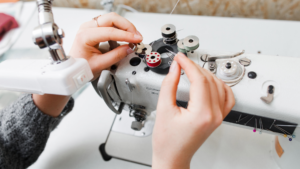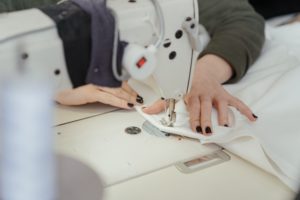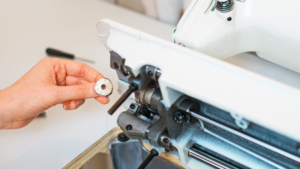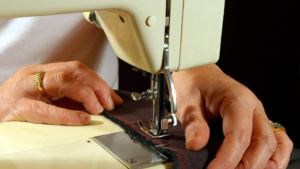Last Updated on June 1, 2022
Several factors can cause a sewing machine to jam and, in this article, we will show you how to fix it.
There’s nothing more aggravating than a jammed sewing machine. Here are several reasons for this problem and some fixes that can help you out.
By the time you finish reading this post, you should have a good understanding of what you’re up against.
Low Feed Dogs
Some machines have feed dogs that you can adjust. However, the cloth will not fully draw through if the tension is not set appropriately. This causes stitches to pile up on top of one another and jamming the machine.
- Make sure your feed dogs are on.
- Watch the handwheel rise above the faceplate as you turn it.
Lint can also accumulate along sections of the feed dogs beneath the faceplate. Remove the faceplate and check for debris throughout the feed dog mechanism.
Wrong Needle
The upper and lower threads may miss each other if you use the wrong needle for the fabric you’re sewing. As a result, you may notice some skipped stitches and uneven threads above and below the material. The machine comes to a halt when the threads become too short.
- Always start a new project with a new needle, according to the rule of thumb.
- Use the appropriate needle size for the job, and ensure the stitch length isn’t too short for lighter-weight fabrics.
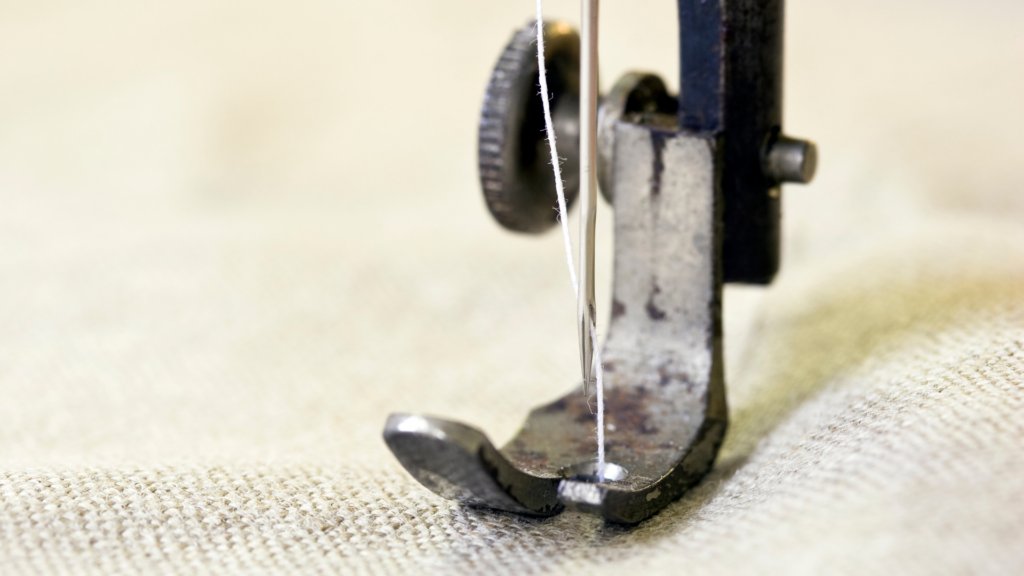
Damaged Needle
Needles can have damage if they come into contact with pins or if they are overworked. A needle might bend if the tension is too high or the fabric is too heavy. A bent needle can get stuck between bobbin sections, breaking or damaging other machine elements.
- Remove your needle and inspect it thoroughly.
- Check the tip for any nicks.
- Check for bends by placing them on a flat surface.
If you’re still not sure, it’s never a bad idea to test a different needle. Keep the discarded needle, especially if it’s a new one, in case it turns out that’s not the issue.
Improper Upper Threading
Improper threading causes the machine’s tension to be either wholly absent or excessive. As a result, the machine may become clogged with thread or come to an abrupt halt, much like a dog on a leash.
- Unthread the machine completely.
- Carefully rethread, ensuring you don’t miss any guides and that the thread is solidly running through the tension grooves. Make sure the spool cap is snugly in place if your thread spool is mounted sideways.
- Examine the spool edges for areas where the thread might catch and stop going smoothly through the machine.
Improper Bobbin Threading
Although bobbins appear to be simple, poor threading can cause a variety of sewing machine problems.
- Remove the bobbin from the sewing machine.
- Remove the bobbin spool from the case if your machine has a front-loading bobbin.
- Reinstall the bobbin, making the thread running through the tension slots on the bobbin case or in the machine properly.
- Catch the bobbin thread with the handwheel and draw it up over the faceplate. Leaving the thread beneath the plate can lead to a thread stuck in the mechanism.

Wrong Presser Foot
Although you can complete most sewing jobs with a basic presser foot, some may require extra attention. For example, a walking or even-feed foot can help handle heavier layers when stitching through multiple layers.
A tool known as a hump jumper is included with some machines. This tool is used to sew over thick seams, such as those seen in jeans, while hemming. To keep the machine from becoming stuck at the seam and jamming in place, use this tool.
- When sewing heavier fabrics, additional presser feet have a specific bottom coating to reduce friction.
- Before stitching any heavy materials, double-check your machine’s requirements.
Poor Thread Quality
Because you haven’t oiled your machine in a long time, it may not function properly. To keep the machinery running smoothly, you must lubricate regularly. Oil your sewing machine once a month or more frequently if you use it often. Every day, add one drop of oil to your machine.
It should neither be overly drenched in oil or too dry, and it is preferable to be dry rather than too wet. For a sewing machine to run well, a drop every day should suffice.
Also, if you haven’t used the machine in a while, oil it thoroughly for a day or two. Then put it somewhere where it will get plenty of sunshine—sunlight aids in smoothing machine parts. This process will ensure that your machine runs smoothly and without jamming.
A Dirty Machine
If not cleaned regularly, errant threads, lint, dust, and even hair can accumulate in machine parts over time. This is especially true in the bobbin compartment, where fabric detritus is pulled down by gravity as you sew.
Debris interacting with machine oil can cause a sewing machine to freeze. These jams can crystallize in extreme circumstances, leading the machine to perform incorrectly or not at all.
Examine all of your machine’s accessible areas. Then, remove dust, lint, and fine threads with a small paintbrush, cotton swab, or tweezers.
- To deep clean, the bobbin region, remove as many components as feasible. Please pay special attention so that you can replace them in the same order as you took them out.
- If any components have crystallized, you may need to treat them with oil and wait for them to soften before removing them.
- After removing all foreign matter, refer to your machine’s handbook to determine which sections need oiling. Take care not to lubricate too much. This could result in fabric discoloration the next time you sew.
Suppose you frequently sew, maintain regularly scheduled maintenance for your machine monthly. This will prevent congestion and potential machine damage.
Short Trailing Thread
The bobbin thread must be pulled above the faceplate and trail several inches behind it. Allow enough thread to prevent it from being pushed down into the bobbin region, causing the machine to jam.
Machine Issues
Several difficulties with the machine can prohibit the fabric from passing through it as it should. For example, when a machine becomes more electronically upgraded, it may have software faults. Now, most of these faults are solved by customer service or a repair shop.
Some machine issues to look for are:
Reverse Function Stuck
Your sewing machine’s reverse lever allows you to sew backward, which helps start a stitch. It’s typical to sew forward and back for half an inch before beginning to sew to keep your stitch in place.
This isn’t a new technique. Sewers do it all the time, and I’m sure other pros do as well, merely to keep their stitching from unraveling. In addition, you can utilize the reverse function to keep your seam in place even after you’ve completed stitching.
We understand the importance of sewing backward, but that doesn’t imply we want the sewing machine stuck in that position. You don’t want your sewing machine to be in reverse since you won’t sew anything.
Foot Pedal Stuck
If your machine is running at top speed, it could be due to a problem with the foot pedal. The foot pedal controls your sewing machine’s pace, so check it out first.
Something may have become caught in the foot pedal. This causes the machine to become stuck at a certain speed. Our advice is to check for dirt and debris to ensure it’s in good working order. If the foot pedal has been thoroughly cleaned and the problem persists, you should inspect the foot pedal’s power cord.
Stuck In Bobbin Mode
There might be a problem with the switch or the programming. You’ll know if the bobbin holder continues to spin while there is no bobbin on it.
Please turn off the machine, then switch it back on again. If this doesn’t resolve the issue, contact customer service.
Handwheel Stuck
This could suggest a jam elsewhere or a faulty or disconnected internal component. You might require the services of a maintenance expert.
Software Issues
Settings like unique stitches or speed settings on programmable machines may become stuck. Try turning off the machine and on again. If that doesn’t work, contact your machine’s customer service line or seek assistance from a repair shop.
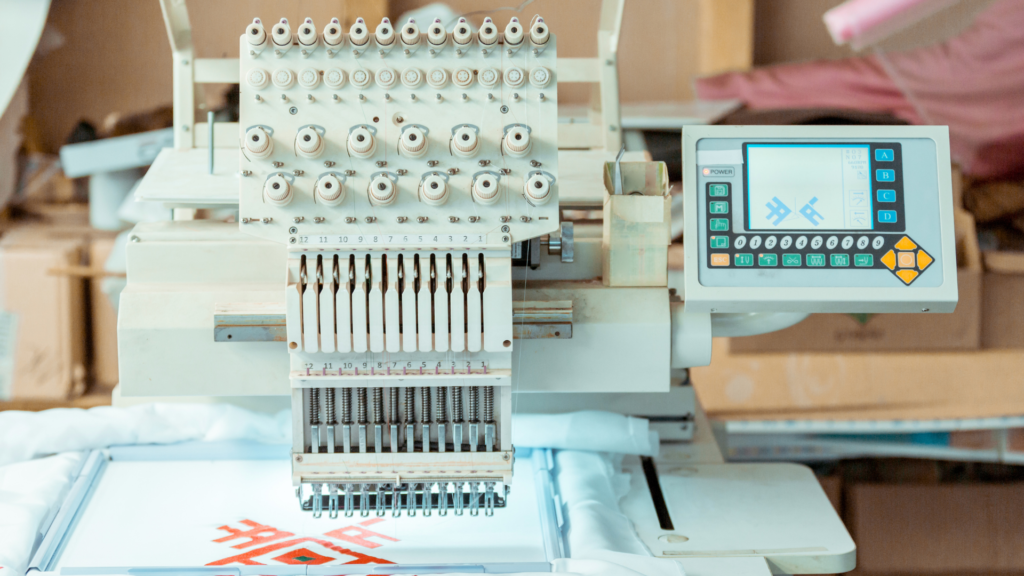
Zig-Zag Mode
When you sew elastic materials or reinforce buttonholes, you use zig-zag stitching. But, just because you need zig-zag stitching doesn’t imply you want your sewing machine in zig-zag mode all the time. What happens, though, if you can’t get it out of the zig-zag way?
If you can’t discover anything valuable in your owner’s manual, you should contact the maker of your sewing machine.
Conclusion
At some point, everyone encounters a jammed machine. And this is not a problem that everyone can fix! However, through this post, you will have an idea why your sewing machine is jammed. If the tips don’t solve the jamming issue, call a repair person.

